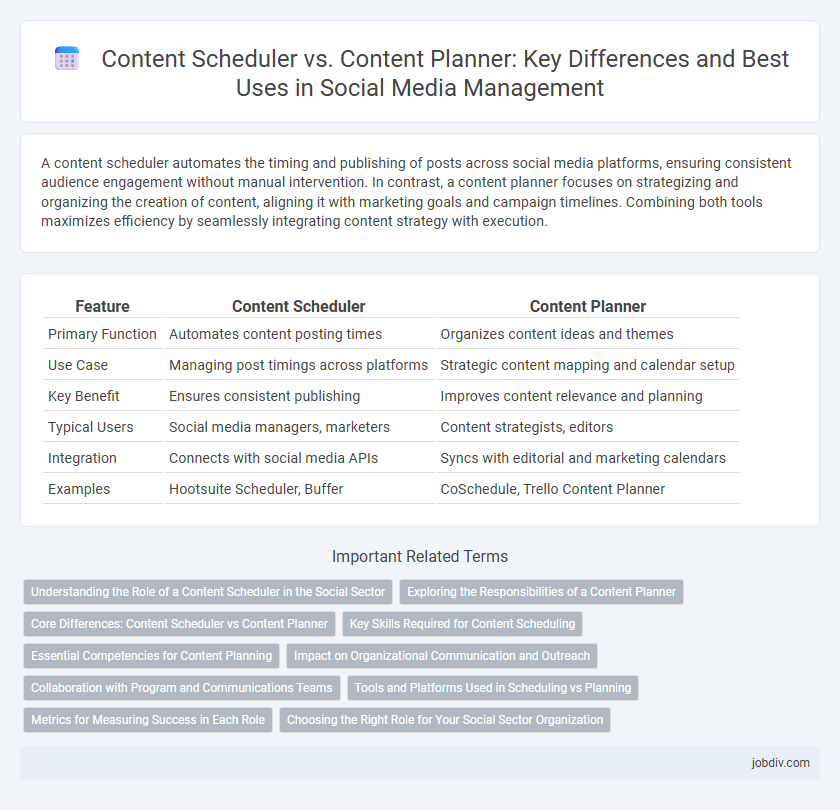A content scheduler automates the timing and publishing of posts across social media platforms, ensuring consistent audience engagement without manual intervention. In contrast, a content planner focuses on strategizing and organizing the creation of content, aligning it with marketing goals and campaign timelines. Combining both tools maximizes efficiency by seamlessly integrating content strategy with execution.
Table of Comparison
| Feature | Content Scheduler | Content Planner |
|---|---|---|
| Primary Function | Automates content posting times | Organizes content ideas and themes |
| Use Case | Managing post timings across platforms | Strategic content mapping and calendar setup |
| Key Benefit | Ensures consistent publishing | Improves content relevance and planning |
| Typical Users | Social media managers, marketers | Content strategists, editors |
| Integration | Connects with social media APIs | Syncs with editorial and marketing calendars |
| Examples | Hootsuite Scheduler, Buffer | CoSchedule, Trello Content Planner |
Understanding the Role of a Content Scheduler in the Social Sector
A content scheduler in the social sector automates the timing and distribution of posts across multiple social media platforms, ensuring consistent audience engagement and optimal visibility. It manages publication calendars and streamlines workflow by allowing pre-planned content to be posted without manual intervention. This role enhances strategic communication efforts by maintaining a regular posting cadence aligned with social campaigns and community outreach initiatives.
Exploring the Responsibilities of a Content Planner
A content planner is responsible for strategizing the overall content calendar, aligning topics with brand goals, and ensuring consistent messaging across platforms. They conduct audience research to identify content gaps and optimize engagement by scheduling posts at peak times. Their role involves coordinating with creators and marketing teams to maintain a cohesive content flow that drives long-term user interaction.
Core Differences: Content Scheduler vs Content Planner
A Content Scheduler automates the timing and publication of posts across various social media platforms, ensuring consistent engagement without manual intervention. In contrast, a Content Planner focuses on the strategic development and organization of content ideas, themes, and goals to align with marketing objectives. The core difference lies in scheduling efficiency versus strategic content creation and alignment.
Key Skills Required for Content Scheduling
Content scheduling demands strong organizational skills, proficiency in digital tools like CMS and social media platforms, and an understanding of optimal posting times to maximize audience engagement. Attention to detail helps ensure accuracy in timing, while analytical skills aid in adjusting schedules based on performance metrics. Effective communication supports coordination with content creators and marketing teams for seamless content delivery.
Essential Competencies for Content Planning
Effective content planning requires mastering essential competencies such as audience analysis, content ideation, and scheduling precision. Content planners excel at strategizing and aligning content goals with brand messaging, ensuring a cohesive narrative. Content schedulers focus on operational execution, using tools to automate publishing timelines and monitor engagement metrics for timely adjustments.
Impact on Organizational Communication and Outreach
Content Scheduler automates the timing and distribution of posts, enhancing consistency and ensuring messages reach audiences at optimal moments, which elevates organizational communication efficiency. Content Planner focuses on strategizing and designing content themes, aligning messaging with organizational goals to improve coherence and audience engagement. Together, these tools optimize outreach by balancing timely delivery with targeted, relevant content.
Collaboration with Program and Communications Teams
Effective collaboration between content schedulers and program and communications teams enhances campaign consistency and timing by aligning publication dates with organizational goals. Content schedulers ensure timely distribution through automated tools, while content planners coordinate messaging strategies and themes to maintain cohesive communication across all channels. Integrating both roles promotes seamless workflow, reducing miscommunication and boosting overall content performance in social initiatives.
Tools and Platforms Used in Scheduling vs Planning
Content schedulers primarily utilize tools like Hootsuite, Buffer, and Later, which focus on automating post timings and managing multiple social media accounts efficiently. Content planners often rely on platforms such as Trello, Asana, and Airtable to organize content ideas, streamline collaboration, and map out editorial calendars in detail. Scheduling tools emphasize execution and timing, while planning platforms concentrate on strategic organization and workflow management.
Metrics for Measuring Success in Each Role
Content schedulers prioritize metrics such as post frequency, timing accuracy, and engagement rates to ensure consistent audience interaction. Content planners focus on tracking campaign performance through key performance indicators (KPIs) like conversion rates, audience growth, and content reach to tailor strategic decisions. Both roles rely on analytics tools to measure success, but schedulers emphasize operational efficiency while planners drive long-term content impact.
Choosing the Right Role for Your Social Sector Organization
Content schedulers automate the timely posting of social media updates, ensuring consistent engagement and audience reach for social sector organizations. Content planners, however, develop strategic content calendars aligned with organizational goals, focusing on message coherence and impact. Selecting the right role depends on whether the priority is efficient execution or comprehensive content strategy development for social outreach.
Content Scheduler vs Content Planner Infographic

 jobdiv.com
jobdiv.com